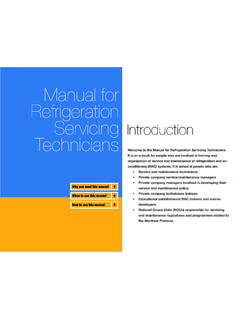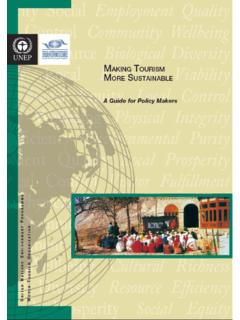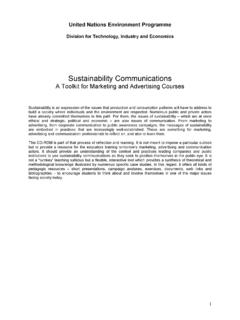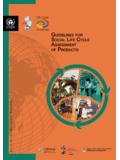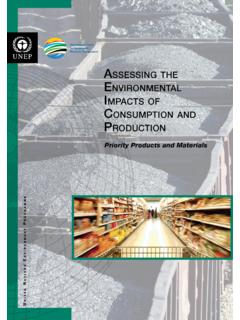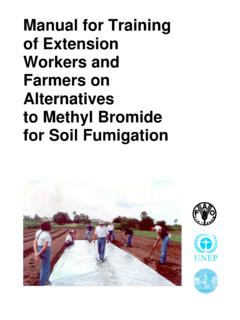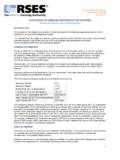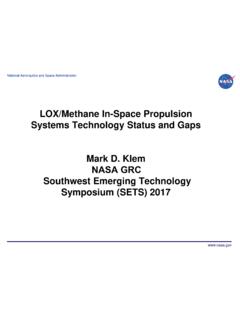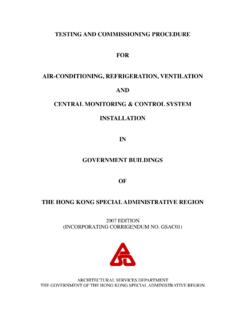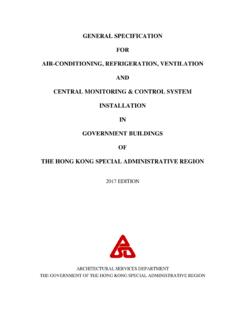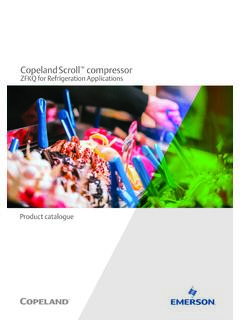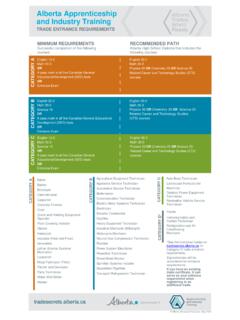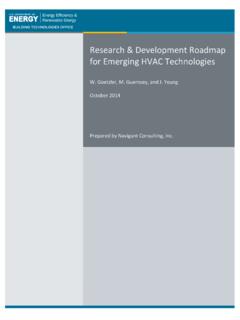Transcription of Manual for Refrigeration Servicing Introduction Technicians
1 Manual for RefrigerationServicing TechniciansIntroductionWelcome to the Manual for Refrigeration Servicing Technicians . It is an e-book for people who are involved in training and organization of service and maintenance of Refrigeration and air-conditioning (RAC) systems. It is aimed at people who are: Service and maintenance Technicians Private company service/maintenance managers Private company managers involved in developing their service and maintenance policy Private company Technicians trainers Educational establishment RAC trainers and course developers National Ozone Units (NOUs) responsible for Servicing and maintenance regulations and programmes related to the Montreal to use this manual4 When to use this manual4 Why you need this manual42 IntroductionOver recent years, attention on the issue of ozone depletion has remained focused on the obligatory phasing out of ozone depleting substances (ODS).
2 At the same time, awareness of climate change has increased, along with the development of national and regional greenhouse gas (GHG) emissions reduction targets. In order to achieve reduction in emissions of both ODSs and GHGs, attention has to be paid to activities at a micro-level. This includes reducing leakage rates, improving energy-efficiency and preventing other environmental impacts, by directing the activities of individuals, and influencing the design and maintenance of equipment. The Manual is written for those who have a relatively comprehensive level of knowledge and understanding of RAC systems and associated technology . The material within this Manual may be used for the purpose of developing training resources or parts of training courses, as well as general guidance and information for Technicians on issues that are closely related to the use and application of alternative refrigerants.
3 Most training courses are likely to cover a range of topics associated with RAC systems, and as such, the material within this Manual may contribute towards those elements that address refrigerant use and you need this ManualRead on to find out how43 IntroductionThe overall theme of this Manual is to encourage Technicians to work with systems in a more environmentally-friendly manner, and to get the equipment itself to have a lower impact. However, the primary motivation for technician operations carried out on a particular system is typically cost-orientated, rather than considering the environmental impact. It is often not recognised that actions resulting in a lesser environmental impact are consistent with a lower long-term cost impact. Conversely, the types of actions that are the cheaper options tend to lead to greater costs in the long term, as well as a worse environmental impact.
4 For example: A system that leaks may be topped-up or repaired. Topping-up may have a lower immediate cost, whereas repairing the leak takes more time and therefore costs more. However, in the long-term, the repaired system is less likely to leak thus the costs cease, whereas repeatedly topping-up a system over months and years results in a very high accumulated cost. Obviously, preventing leakage and thus fewer journeys to the equipment and better resulting efficiency is much more desirable from an environmental perspective. A system that is designed to work efficiently and is well maintained may cost more to build, but the pay-back period is generally much shorter than the equipment s lifetime. Similarly, the additional GHG emissions associated with constructing larger heat exchangers (for example) are minute compared to the reduction in GHG emissions from energy consumption that will be saved over the first year of operation.
5 So, when installing a new system or working on an existing system, the actions taken should ideally lead to the system operating with minimal impact on the environment. To achieve this, several aspects should be borne in mind: Reduce energy consumption by minimizing heat load and improving efficiency. Minimize leakage and other emissions whenever possible. Avoid the use of high global warming potential (GWP) to use the manualRead on to decide how you might use this Manual to achieve this44 IntroductionThe objectives on the page 6 When to use this Manual may be achieved through a variety of means, including those detailed within this Manual and from other sources. When a technician arrives at a system to carry out activities that involve refrigerant handling, and as they begin their work, they must formulate a view as to how to deal with the system in hand. The considerations as to what to do with the system may include:Repair: Whether to repair and refill with the same refrigerant change: Whether to repair and drop-in with a new refrigerant, and if so, which refrigerant to use.
6 Retrofitting: Whether to repair and retrofit with a new refrigerant, and if so, which refrigerant to : Whether to repair, and add refrigerant, but also carry out other improvements to improve the reliability and : Whether to replace the entire system with a new one, and if so, which system and which refrigerant. How to use this manualRead The Factors Affecting the Decision45 IntroductionThe Factors affecting the decisionThe decision as to which approach to take is rarely an obvious one, and requires consideration of many of refrigerant and its availabilityIf a system uses a chlorofluorocarbon (CFC) then it is likely to be difficult to obtain, or even prohibited. The same will apply to hydrochlorofluorocarbons (HCFCs) in the of leakageFor systems that have a history of high leakage, perhaps due to poor manufacture or construction, or being positioned in a vulnerable location, consideration should be given to replacing them, or redesigning/reinstalling the susceptible of refrigerantIf a system has a small charge of controlled or less available refrigerant, then it may not be so problematic to retain it, whereas if the charge is large then it would be sensible to replace of alternative refrigerantThe choice of alternative refrigerant should ideally be a substance with zero ozone depleting potential (ODP) not a CFC or HCFC or a blend that contains either.
7 It should have as low a GWP as size of the systemIf a system is very large, replacing it with a new system may require considerable of similar (replacement) systemsIf the system is particularly complex and a replacement is being considered, it should only be done provided a replacement system is easily of expertise associated with the type of systemInvolved types of work or replacing parts or the entire system should only be done provided that sufficient expertise is of integration into applicationWhere a system is partially integrated into an application or a building, or is part of a much larger mechanical installation, it is likely to be much easier and more cost effective to carry out minimal work rather than trying to replace it with a new of equipmentFor systems in a very poor condition, where perpetual maintenance and repairs are likely, then installation of a new system may be of systemIf a system is very old and is using outdated technology and parts, it could be appropriate to replace it.
8 Whereas newer equipment may have modern design and already use suitable level of reliabilityIf the reliability of the system and its components are poor, resulting in repeated service visits and losses of parts and refrigerant, then a replacement system may be the preferred efficiency and potential for efficiency improvementIf a system has a poor level of efficiency, it is necessary to consider whether there are viable operations that could be carried out to help improve the efficiency, but it is such that this is not possible, then adoption of a new system should be choice is often complex and a function of many different factors. Typically, the age of the equipment is a leading factor in terms of which conclusions are drawn in terms of how the equipment should be handled, for the reasons implied above. 7 IntroductionHow to assess conditionsHere is an overview of conditions for the refill, drop-in, retro-fit and new system options, which includes considerations that should be given to how a system is handled.
9 Considering these factors, read the conditions below and then select the option you might chooseThe conditions4 CHAPITRE 1 PAGE 06 HOW TO ASSESS CONDITIONSEXISTINGSYSTEMNOT MANY YEARSOLD ?SMALL CHARGE ?GOOD POTENTIALFOR EFFICIENCYIMPROVEMENT ?GOOD EFFICIENCY ?SYSTEM IN GOODCONDITION ?HCFC , HFC ,NATURALREFRIGERANT ?LIMITEDAVAILABILITY OFNEW SYSTEMS ?FULL INTEGRATEDINTO APPLICATION ?LOW LEAKAGE ?NO EXPERTISE FORNEW SYSTEMS ?GOOD RELIABILITY?NEWSYSTEMMANY YEARS OLD ?LARGE CHARGE ?POOR POTENTIALFOR EFFICIENCYIMPROVEMENT ?POOR EFFICIENCY ?SYSTEM IN POORCONDITION ?CFC REFRIGERANT ?EXTENSIVEAVAILABILITY OFNEW SYSTEMS ?NOT INTEGRATEDINTO APPLICATION ?HIGH LEAKAGE ?EXTENSIVE EXPERTISE FOR NEW SYSTEMS ?POOR RELIABILITY?8 IntroductionCondition Observation Refrigerant type and availability HFC, CO2, HC, NH3 CFC, HCFC HCFC CFC Severity of leakage low low medium high Charge of refrigerant high medium medium low Alternative refrigerant availability poor good good good Physical size of system large large medium small Availability of similar systems none none none many Availability of system expertise none some some much Degree of integration high high medium low Condition/state of equipment good good fair poor Age of system new medium medium old Current level of reliability good good fair poor System efficiency good good medium poor Efficiency improvement potential good good medium poor Recommended action.
10 Repair and refill Drop-in Retrofit New system 9 IntroductionCharacteristics of Selected Types of EquipmentDifferent types of equipment have certain characteristics associated with them, that may affect some aspects of the decision-making and some of these are listed in the Characteristics of Selected Types of Equipment sheetApplication example System Type Relative Charge Integrated into Application Domestic Refrigeration integral small low Stand alone retail food display and vending integral small low Condensing unit Refrigeration remote medium medium Large supermarket systems distributed large medium Cold storage remote large medium Industrial process Refrigeration all medium, large high Refrigerated transport remote medium high Split and ducted air conditioners remote medium medium Portable & window air conditioner units integral small low Heat pumps all medium, large medium Chillers integral medium, large medium Mobile air conditioning (MAC) Integral small high 10 IntroductionFurther informationThe information within this Manual was drawn from a variety of different sources.
